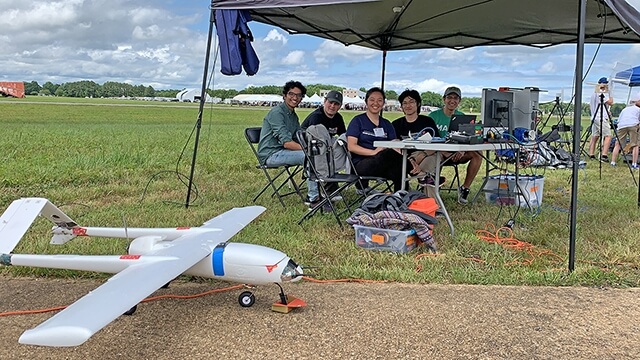News
The skies are getting more crowded. The Federal Aviation Administration estimates that there are currently 1.25 million unmanned aerial vehicles (UAV) in the United States. By 2023, the market will triple in size and nearly 1 million UAVs will be airborne over U.S. cities at any time.
While the hobbyist market is booming, UAVs capable of autonomous flight are also reshaping many industries, from agriculture (crop monitoring) to health care (medicine delivery).
But developing an autonomous UAV presents a number of engineering challenges, as members of the Harvard College Aeronautics Club discovered this summer.
They debuted their pilot-free plane at the International Student Unmanned Aerial Systems Competition at the Patuxent Naval Air Station in Maryland, and claimed 16th place out of 75 international teams. The Harvard John A. Paulson School of Engineering and Applied Sciences team was the only first-time team to achieve autonomous flight.
“The whole competition really boils down to a systems engineering challenge,” said Lev Bershadsky, A.B. ’21, a physics concentrator. “You have all these different systems that you have to make sure are working together—the plane, the autopilot, the video streaming. Integrating all of that was the hardest part.”
Developing the aircraft was a complex challenge; the team began working on the project in the fall of 2017 as a part of the Harvard Undergraduate Robotics Club. With such a complicated and unique project, they spun out of HURC last year to form their own club, which has about a dozen student members.
They used a kit to build a robotic airplane, with a two-meter wingspan and an inverted v-tail to provide enhanced stability. The students modified the design for the competition, retrofitting the aircraft to hold the camera, vision system, and flight controller that would enable autonomous flight.
“The biggest difference compared to other robots we’ve worked on is that the cost of failure is very, very high,” Bershadsky said. “To really test it, you need to take it out to the field and fly it. If something fails and it comes down, pretty much everything is gone and you have to start from scratch.”
The team developed software for their UAV that downloads a mission, locates waypoints, and then plots a paths for the aircraft that avoids obstacles. (Photo provided by the Harvard College Aeronautics Club)
While the hardware team tweaked the plane’s design with those high stakes in mind, another group wrote software to control the plane’s movement. The software downloads a mission, locates waypoints, and then plots paths for the aircraft that avoid obstacles, explained George Moe, A.B. ’21, a computer science concentrator.
The team also created a user interface so they could see the plane’s location and remaining battery life.
“The biggest challenge we faced came down to testing. Simulation is one thing, but reality is another,” Moe said. “At the competition, the software worked great, but we didn’t account for connectivity issues with the plane. You can have the greatest software in the world, but if you can’t upload directions to the plane, it doesn’t do any good.”
The team was able to improvise, manually launching their plane and keeping it in the air long enough on autopilot to score points for autonomous flight.
Drawing on those experiences, the team will refine their design and improve their software and Wi-Fi system for next year’s competition.
Despite some setbacks, Moe is proud of the team’s efforts. The club, which is open to students of all concentrations, helps its members develop valuable problem-solving skills in a high stakes environment, he said.
“It was an excellent, hands-on experience to apply the skills and thinking that we’ve learned in our coursework into a real challenge, which is messy,” he said. “There were physical parameters involved, as well as the need to work well together as a team. You have to really think about how you coordinate this large effort and use the entire team to accomplish this really difficult task.”
Topics: Student Organizations
Cutting-edge science delivered direct to your inbox.
Join the Harvard SEAS mailing list.
Press Contact
Adam Zewe | 617-496-5878 | azewe@seas.harvard.edu



